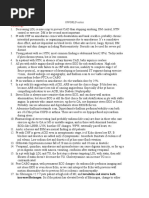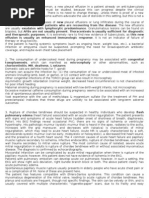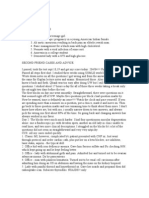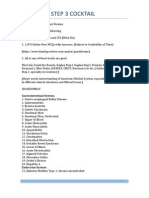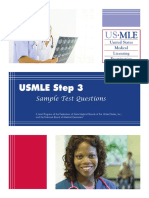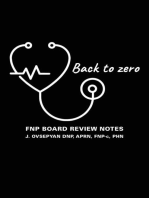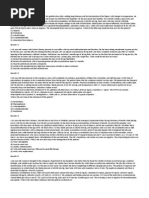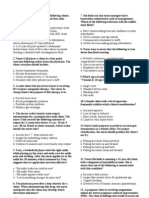PracticeExam CCS
PracticeExam CCS
Uploaded by
Behrouz YariCopyright:
Available Formats
PracticeExam CCS
PracticeExam CCS
Uploaded by
Behrouz YariOriginal Description:
Copyright
Available Formats
Share this document
Did you find this document useful?
Is this content inappropriate?
Copyright:
Available Formats
PracticeExam CCS
PracticeExam CCS
Uploaded by
Behrouz YariCopyright:
Available Formats
CCS #1 -Barbiturate overdose ________________________________________ In small doses, the person who abuses barbiturates feels drowsy, disinhibited, and
intoxicated. In higher doses, the user staggers as if drunk, develops slurred speech, and is confused. At even higher doses, the person is unable to be aroused (coma) and may stop breathing. Death is possible. It has a narrow therapeutic-to-toxic range. This is the reason why barbiturates are dangerous. It is also why barbiturates are not prescribed often today. In addition to having a narrow therapeutic range, barbiturates are also addictive. Symptoms of withdrawal or abstinence include tremors, difficulty sleeping, and agitation. These symptoms can become worse, resulting in life-threatening symptoms including hallucinations, high temperature, and seizures. Pregnant women taking barbiturates can cause their baby to become addicted, and the newborn may have withdrawal symptoms. Lab: CBC, chem 7, urine tox screen, ABG EKG, C xray Treatment: The treatment of barbiturate abuse or overdose is generally supportive. The amount of support required depends on the persons symptoms. If the patient is drowsy but awake and can swallow and breathe without difficulty, the treatment just monitor the patient closely. If the patient is not breathing, mechanical ventilation until the drug have worn off. Activated charcoal may given via nasogastric tube. Start on Naloxone, Thiamine, Glucose, & IV fluid. NaHCO3 to alkalize the urine Admitted to the hospital or observe in the Emergency Department for a number of hours. Advice the patient about drug abuse or Psychiatric consult. CCS # 2 Anemia in an elderly male. Colorectal cancer is the second leading cause of cancer death in the United States. True primary prevention includes: 1. Stressing a low fat, high fiber diet, adequate calcium intake, and identification of any risk factors such as a strong family history of colon cancer, which might increase an individual's risk. 2. Dietary supplementation with D-Glucarate is an exciting new approach. Most colon cancers develop from benign polyps. Screening for Colorectal Cancer: 1. An annual fecal occult blood test. 2. Flexible sigmoidoscopy once every 3-5 years to detect colorectal cancer at its earliest and most treatable stage. Begin at age 50. 3. An annual colonoscopy is recommended for high risk patients of any age with prior history of cancer, a strong family history of the disease, or a predisposing chronic digestive condition such as inflammatory bowel disease. Colon cancer screening age 40: DRE/every yr age 50: DRE + fecal blood test/every yr, flexible sigmoidoscopy every 3 yrs High risk: 1) FH/O colon cancer in 1st degree relative-age 40: DRE + fecal blood test/every yr; flexible sigmoidoscopy and Barium enema or colonoscopy every 3-5 yrs after 2 normal exams 1 yr apart 2) IBD of 8 yr duration: colonoscopy every yr What are the Symptoms of Colon Cancer? Right sided, ascending colon tumors often present with fatigue, weakness, and anemia of iron deficiency of unknown origin. Left Sided, changes in bowel habits ( constipation and/or diarrhea ), crampy left lower quadrant pain and even perforation. HPI: A 60 year old male presenting to office for regular checkup. Or patient has mild anemia and tiredness. PE: Complete LAB & Diagnostic Investigations: 1. CBC with Diff. 2. UA 3. Chem-12 4. Lipid profile 5. Because of his age he needs fecal blood test, If positive followed by colonoscopy. result will show evidence of colon cancer. 6. Liver function tests, Chest x-ray to look for metastatic disease. 7. CT scan: to evaluate the extent of CA or metastases. Management: 1. Evaluate the Colonoscopy result. 2. After initial workup admit patient for elective surgery. 3. Surgery consult. Get type and cross, CBC, Chem 12, EKG, CXR, PT, PTT, LFT, inform consent, NPO, and CEA level prior to
surgery. 4. Start patient on Iron if hgb is very low. 5. After surgery patient should be evaluated every 3-6 months for 3-5 yrs with history, physical examination, fecal occult blood testing, liver function tests, and CEA determinations. 6. Colonoscopy is performed within 6-12 months after operation to look for evidence of recurrence and then every 3-5 years. CEA: used as a marker for colorectal tumor growth postoperative (recurrence). Educate patient and family: Advice patient about High Fiber Diet Final Diagnosis: Colon Cancer ________________________________________ CCS #3 Typical case of Cholecystitis. Patient mostly comes with fever, chills and RUQ tenderness, muscle guarding worse with inspiration. Lab: CBC, UA, serum amylase & lipase, LFT, B-HCG if female pt. PT/PTT, blood type & screen. First choice for evaluation is U/S. if it is biliary colic, sonogram will make the diagnosis. If sonogram is doubtful, then HIDA can make a diagnosis. Recognize appropriate treatment of asymptomatic gallstone disease. Management If pt has pain and fever start on : Cipro 500 mg Bid for 10 days or Metronidazole 500 mg TID for 10 days. Bentyl 20 mg Tid, AC for 10 days. If pt has acute severe pain, nausea & vomiting: Hospitalize, NG tube, IV antibiotics, IV fluids, narcotics (Meperidine) Good response: Plan surgery after acute attack is over Poor response: Immediate surgery Except under very unusual circumstances the gall bladder should be left alone. Exceptions include a concomitant porcelain gallbladder (risk of cancer), patients unable to clear Salmonella typhi infection, and possibly sickle cell patients. If chronic small stones: Trial of ursodiol is beneficial. CCS # 3 Cocaine-related myocardial infarction: ________________________________________ HPI: A 22 y/o man comes to ER with chest pain, tachycardia, High BP ... Lab: CBC, chem 7, UA with tox screen. EKG, Cardiac Enzymes. The accurate identification of patients with cocaine-related myocardial infarction can be difficult as the EKG may be abnormal in many patients with chest pain after cocaine use, even in the absence of acute MI. Treatment: Airway, O2, IV fluid, Monitor. If BP still high consider Nitroprusside (B-Blockers are contraindicated) Diazepam to reduce agitation & help resolve chest pain. The routine use of thrombolysis in patients who may have cocaine-related infarction is not advised. Thrombolytic therapy should be considered only after treatment with oxygen, aspirin, nitrates, and benzodiazepines has failed, and when immediate coronary angiography and angioplasty are not available. Admit to ICU if not stable (cardiology consult) Psychiatric consult. CCS # 4 Typical case of Cholecystitis. ________________________________________
Case #5: 65-year-old white woman with left-sided chest pain Initial History/Vital Signs: 65-year-old white woman with left-sided chest pain Anxious and sweating Has tachycardia and tachypnoea, with bounding pulses Severely hypertensive Comment Acute onset of sharp chest pain that radiates to the back in a hypertensive woman in the 7th decade of life makes aortic dissection very likely. We must proceed rapidly.
Differential diagnoses at this time would include: Aortic dissection (top on the list) Myocardial infarction Musculoskeletal pain Pneumothorax Costochondritis Comments As stated above, there is little doubt that this patient has aortic dissection. A close differential would be myocardial infarction. Chest pain not made worse by breathing indicates that the pleural is not involved, and neither is it a result of In any case, we need to address her problems without delay. Our next move is physical examination. Click the appropriate buttons and select the following: general appearance (remember case #1? You must always examine the patients general appearance) skin chest/lungs cardiovascular system abdomen extremities
Comment The major findings are in the cardiovascular system. Bounding pulse with decrescendo murmur poiint to aortic incompetence. These findings lead us more towards dissection of the aorta. We need to quickly order laboratory investigations. Appropriate investigations to order now: 12-lead ECG stat. Chest X-ray (AP, portable) cardiac enzymes pulse oxymetry (if low then request ABG) CT scan of chest
Comment As a rule of thumb, all patients with chest pain should have the above investigations done. a 12-lead ECG helps us rule in or out the heart as the cause of her chest pain. Portable chest x-ray can be rapidly done right in the ER. Without waiting for the results of these investigations, we will now start treatment: Click on the order button and enter the following orders, one per line morphine, intravenous, continuous phenergan, I/V, continuous (Antiemetic) oxygen by inhalation atenolol I/V bolus for elevated blood pressure
Comment Morphine is for pain; phenergan is an anitemetic (emesis is a common side effect of morphine) We have done what we can do for the patient for now. Let us find out how our patient is doing. We are going to take interval history. Click on Interval Hx/PE and select Interval/Follow up Chest/lungs Heart/CVS We discover that oxygen saturation is 96% (acceptable; ABG not needed at this time). Otherwise, no change in patient's condition. We will now advance the clock to see patient with next available result: ECG shows sinus tachycardia and left ventricular hypertrophy Comment This effectively rules out myocardial infarction. We still need to review the result of serum cardiac enzyme determinations, though. The patient has received only partial relief. Click ok to continue. We need more results before we can make managemenbt decisions. Keep on advancing the clock. X-ray result shows mediastinal widening CT scan shows ascending aortic dissection Patient's blood pressure improves. We must now send a consult to the specialists. Click the order button and order: consult to cardiovascular surgeons (reason: probable aortic dissection) consult to cardiologists (reason: probable aortic dissection)
Click on the Change Location button to the right of the screen to move patient to the ICU. Confirm move Take interval/follow-up history Examine chest & cardiovascular system order atenolol PO continuous (if BP remains high) Patient is now feeling better. We need to get some laboratory results. Advance the clock to next available result Cardiac enzyme comes back, ruling out MI. BP is now within normal range. We must discontinue some of her antihypertensive medications, lest she becomes hypotensive. Click on Triamterine once. Confirm cancelation. We may leave her on atenolol and thiazides. Final diagnosis: Ascending aortic dissection ________________________________________ Case #6 : 25-year-old male patient with three-week history of diarrhea Initial History: Essential Facts: Three week history of mucoid, non-bloody diarrhea Has prolonged diarrhea (three weeks) There is associated abdominal cramps Comments Diarrhea wakes patient up, meaning it is a non-functional diarrhea; functional diarrhea will not wake patient up. It is of recent onset, so irritable bowel syndrome is unlikely. Diarrhea is mucoid, so there is an infectious etiology; it is non-bloody, so there is no invasiveness of the GI tract. Differentials at this time include: Infectious diarrhea (e.g. Giardiasis) Dysentery Inflammatory bowel disease Giardiasis is one of the commonest causes of diarrhea in the adult population Let us go on to perform the physical examination. We are interested in the following systems Physical Examination: General appearance Abdomen/rectum Extremities Cardiovascular system Skin Lungs Confirm your choice of PE. Afterwards, click on the Order button to place the following orders. Electrolytes BUN/ Creatinine CBC statim Stool for ova and parasites, C/S, clostridium Serum amylase and lipase to rule out Pancreatitis. Amylase is sensitive but not specific; lipase is specific but not sensitive Abdominal X-ray to rule out toxic megacolon/perforation, acute series
Comments We have done everything we can do at this stage. Let us advance the clock to see the next available result. What we do next will be determined by what we get from the lab results. Advance the clock until you get the results: Ova and parasite: positive for Giardia lamblia Now that our diagnosis is confirmed, it is time to treat the patient. Click the Order button below the screen and order Flagyl oral, continuous We can now schedule an appointment for the patient. Let us see him in 1 week for follow-up. Diagnosis: Giardiasis End of case source first pass ________________________________________ Case #7: 5-year-old boy with recurrent nosebleeds Initial History: Essential Facts: 5-year-old white boy Upper respiratory tract infection 2 weeks previously, successfully treated with acetaminophen and pseudoephedrine Recurrent nosebleeds for 24 hours, now unresponsive to direct pressure Purpuric lesions on legs for 24 hours No history of falls, no family history of abnormal bleeding, no previous history of similar problems Appetite good; no signs of systemic infection
Comments Recent onset of nosebleeds and presence of purpuric lesions point to problems with coagulation. Good appetite and absence of systemic signs of infection are good signs. Initial vital signs: essentially normal Differential diagnoses at this stage: platelet disorders (e.g immune thrombocytopenic purpura) clotting factors disorders blood vessel disorders Comment Platelet disorders tend to cause bleeding into the skin and mucous membranes; clotting factor disorders would be expected to cause more deep seated bleeding (e.g. into joints, hematomas). Because the abnormal bleeding is of recent onset, vascular disorders are unlikely. Clotting factors are not likely to be the cause of bleeding either, because this patient has not had similar problems in the past. The presence of purpura together with a recent history of (?viral) respiratory illness will make us consider platelet disorders. Idiopathic thrombocytopenic purpura (ITP) is a strong differential at this stage. Let us begin the management of the patient. Initial Orders: Nasal packing CBC Prothrombin time (PT): aPTT (activated partial thromboplastin time) Serum Electrolytes BUN Serum Creatinine Group and screen blood (patient might need transfusion later; lets get serum ready) Bleeding time (optional; see below) Comment We began with nasal packing because the patient is bleeding right now. This should relieve his anxiety for a time. Complete blood count (CBC) was ordered because we are considering platelet disorders as a possible cause of the patients problems. CBC will help us determine the platelet count. PT measures the integrity of the extrinsic and common pathways of the coagulation system, while aPTT helps us determine the intactness of the intrinsic and common pathways. Advance the clock by 10 minutes (not rigid; you may use 5 or even 15 minutes, if you choose) to review the patients condition Click on interval history and HEENT examination. You receive a message that patient is feeling better Advance the clock to the next available result our initial suspicion of thrombocytopenia is confirmed. Let us order treatment. Platelet is low By now we know pretty much that this patient most probably has ITP. The most appropriate treatment for this condition is corticosteroids. Order treatment: Prednisone, oral continuous Write consult to pediatric hematologist Routine, probable ITP Reorder CBC 1 time routine (repeat for the day, subsequently 12 hourly) Admit to the ward Diagnosis: ITP Discharge on prednisone when platelet is 50,000+ (bleeding unlikely then), and review again after a few days (say, 1 week) for a repeat determination of the CBC. It should be well close to normal. source- first pass Case #8 (from sample CD): 32-year-old black woman with pain ________________________________________ Case #2: 32-year-old black woman with pain and swelling, right knee Case Introduction: Essential Facts Patient is black, 32 years old She has a one-week history of knee pain (right) She comes to the office Comments Pain and swelling of the knee developed gradually over a period of one week. This is unlikely to be due to trauma. The differential diagnoses are too many to be listed here, so lets learn more about the patient first. Initial Vitals: Essentially normal Initial History: Essential facts Symptoms began 2 months ago with fatigue and generalized weakness
Followed by generalized body aches, prolonged early morning joint stiffness, pain and occasional swelling in both wrists Her symptoms are moderately severe, not responsive to mild analgesics She does not engage in unsafe sexual practices Possible differential diagnoses at this stage include: Systemic lupus erythematosus (SLE) Rheumatoid arthritis Gonococcal arthropathy Reiters syndrome Osteoarthritis Comments Gonococcal arthropathy is unlikely (though remotely possible) because of her history. It is more likely in patients who engage in unsafe sexual practice4s, or those with multiple sexual partners. Osteoarthritis (OA) is also unlikely because of the duration of the stiffness. The stiffness of OA generally resolves after a few minutes, up to a maximum of 30 minutes. Reiters syndrome is more common in men, is associated with urethritis, uveitis and arthritis. However, this patient has neither urethral nor eye symptoms, so this differential is also unlikely. We are now left with SLE and RA. The next step is to perform physical examination. Click the Interval History and PE button on the left side of the screen, and check the following regions under Physical Examination: General Appearance (almost always necessary) Skin (Reiters disease has skin manifestation) Chest/Lungs Heart Cardiovascular Abdomen Extremities Genitalia
Comments Notice that we are taking our time with the physical examination. This is because the patient presented to the office, and her situation is not life threatening, so we can afford to take our time for proper examination. Physical Examination: Essential Findings Bilateral warmth and swelling, both wrists and knees Rest of examination normal From the foregoing, it is clear that we are dealing with rheumatoid arthritis. Lets now proceed to treatment. Click the Write Order button, and enter each of the following (one per line): X-ray (knee, wrist, routine (you can choose both by pressing Ctrl in Windows, and selecting both knee and writs x-rays) ESR (routine) Complete blood count (with differentials). Routine Rheumatoid factor (routine) Antinuclear antibody (ANA) titer, serum
Comments Notice that there are two choices for ANA. The first choice is ANA, serum, and the second, ANA titer, serum. ANA serum only measures the presence of ANA, while the other test quantifies the amount present in the serum, if any. We are more interested in knowing how much of ANA is in the serum, so we choose the second test. Also, note that it will take a total of six hours before all the results of these tests are available. That means we must proceed with treatment even before we see any of the results. The patient cannot sit still for six hours, untreated, while we await the results of the lab tests. Let us start with arthrocentesis. We would like to drain some fluid from the swollen knee joint. Click the Order button at the bottom of the screen and enter the following orders: Arthrocentesis (confirm your choice by advancing clock for 20 minutes) On the joint fluid drained from the knee, order the following tests: rule out gout Crystals (routine) rule out infections Cell count (routine) Culture joint fluid (routine) Gram stain (synovial fluid is closest). Order this stat.
All the tests have now been sent to the lab. We can obtain the result of gram stain within 20 minutes. Let us advance the clock, so that this result will become immediately available. Click on Obtain Results and see patient in 20 minutes. The result of gram stain is displayed (normal in this case). We can now continue with further treatment. Click Order button at the bottom of the screen and enter: Ibuprofen (oral, continuous) Patient may go home, for re-evaluation with results the next day. FAQ: Since we are fairly certain that this patient has RA, why cant we just start steroid treatment right away? Answer: The big question is, what would happen to this patient if we wait to confirm our suspicions? Nothing! Remember, you are expected to manage each patient in the most standard manner possible. It is not standard practice to begin treatment of cold cases without confirming the diagnosis. Schedule an appointment for the patient for the next day (Click See patient Later button, select See Patient In and enter 1 in the
day column on the right). Continue to advance the clock until you see the results of the tests done earlier. Lab and Radiological Results: Essential Findings X-ray, knee: inflammatory arthritis No crystals in synovial fluid Cell count, synovial fluid: 14,000 wbc/cmm, 35% polymorphs ESR: 47 mm/hr CBC: Normal Rheumatoid factor (RF): moderately high ANA: Negative Our next move is to do interval follow up, and check the patients extremities. Click Interval History, and select Interval/Follow up, Extremities. The results are essentially unchanged from before. Meanwhile, our results have confirmed rheumatoid arthritis (RA) as the cause of the patients pain. Let us start the patient on prednisone. Click the Order button and enter Prednisone (oral, continuous) Advance the clock by 1 day, so that we can see a lab result. Culture result is normal. Perform interval follow up once more, and examine the extremities. The results have not changed much. Since we are sure that our treatment is right, we will make no changes at this time. Give the patient an appointment for 4 or 5 days. When she arrives, take an interval history and perform an interval physical examination. The patient now feels better than before. She will continue her treatment as before, and see us in 14 days. Book her an appointment for 14 days. When she arrives, perform the appropriate assessment. You will discover that she now feels much better. Slight swelling persists. Let her continue her medication, and see us again in 14 days. At this stage, the case is about to end. We may discontinue ibuprofen, since there is no need for it at present. On the other hand, we may let her continue with it. Final diagnosis: Rheumatoid Arthritis End of case. source first pass CCS# 9 - Pregnant woman in shock, Amenorrhea, ________________________________________ Ectopic Pregnancy. Pregnant woman in shock, Amenorrhea, abd. pain, & vaginal bleed. The most common place is in the fallopian tube. Causes the ectopic pregnancy? 1. Advancing age 2. Pelvic inflammatory disease (# 1 risk factor) 3. Previous ectopic: about 10-20% of those attempting pregnancy after one ectopic will have another. 4. Tubal surgery or defects 5. Previous termination of pregnancy 6. DES exposure 7. IUD Most patient report missed period, positive pregnancy test, some abdominal pain, and some irregular vaginal bleeding. Some women report fainting or suddenly, without warning a woman is very unwell, collapses and is taken to hospital. Lab: CBC, UA, HCG, blood T&C What tests are used to diagnose ectopics? 1. Obviously first of all a pregnancy test. If the test is negative then ectopic pregnancy is virtually excluded. 2. Transvaginal ultrasound can reliably demonstrate a pregnancy in the uterus from about 5 weeks onward. If TVUS is negative and HCG is < 2000 mIU/ml repeat HCG in 48 hrs, subnormal increases Ectopic probable. Treatments? * Start IV fluid, O2, blood transfusion if required * Medical treatment: with a drug called methotrexate, which is given by injection. This makes the ectopic pregnancy shrink away by stopping the cells dividing, tube pregnacy must be small (less tan 4 cm) and low B-HCG. * Laparoscopic surgery: open the tube and remove the pregnancy (salpingotomy), or remove the tube (salpingectomy). * Laparotomy: either salpingotomy or salpingectomy performed.
CCS #10 Sickle cell crisis in 7 year old- An African American boy ________________________________________ Sickle cell crisis. An African American boy presenting with lower back pain, colicky abdominal pain and Sickle cell dx - ER There are three main types of sickle cell disorders: 1. Sickle cell anemia 2. Hemoglobin SC disease (for sickle SC disease, remember that hematuria is more commonly found in it) 3. Sickle beta-thalassemia Patients can develop many types of problems due to sickle cell disease. Anemia leads to fatigue.
Aplastic crisis: Pallor is an important sign. One should also be alert after a non-specific fever that may be due to Parvovirus B19. Parvovirus infection can precipitate Aplastic crisis. Hand-and-foot syndrome: This is usually one of the earliest signs due to infarction in the digital bones and blood vessels.. Painful episodes called "sickling crisis" usually requires opiates to abort the pain. Severe infections: Due to sickling in the splenic vessels, the spleen slowly dies due to multiple infarcts. These patients have reduced immunity (because spleen introduces antigens to the lymphocytes to evoke good antibody response). Encapsulated organisms including Streptococcus pneumoniae and Hemophilus influenzae are particularly left unchecked. Splenic sequestration crisis: Spleen goes crazy and suddenly pools in and holds on to a large number of blood cells. Characterized by LUQ pain and abdominal pain. Stroke: This again is due to sickling and clogging up of capillaries. Acute chest syndrome: Fast or difficult breathing, chest pain, high fever, and coughing are symptoms of Acute Chest Syndrome.15% to 43% of sickle cell population will contract ACS. One can find hypoxia (paO2<60 and sats <90%). One would also find infiltrates in the lungs. Usually bilateral. Lab test: CBC with diff, Reticulocyte count, LDH. In Aplastic Crisis: low Hct & Reticulocte count. Hb electrophoresis reveals Hb S. If diagnosis not known. Blood Culture to exclude infection Blood T&C UA: Mic. Hematuria. & culture Xray: if there is back or feet, hands pain- bone necrosis Once diagnosed with the acute chest syndrome, patients should be given: OXYGEN Hydration: I.V. NS Strong analgesics (iv), Morphine or Hydrocodone then switch to Ibuprofen. Broad spectrum antibiotics, including a macrolide Bronchodilators. Packed RBCs transfusion if the hemolysis is severe Folic acid Ophthalmology consult for retinopathy - Laser photocoagulation. Sequestration Crisis (low Hgb & pancytopenia): consider splenectomy If they are at high risk for complications (adults and those who have a history of cardiac disease and severe pain in the arms and legs), patients should be given early transfusions. One drug that has improved the quality of life for sickle cell patients is Hydroxyurea. It is known to increase the level of fetal hemoglobin in the patient and prevents excessive deoxygenation. It also decreases the level of sickle hemoglobin. Peculiar problems of sickle cell disease also include Salmonella osteomyelitis, proliferative retinopathy and avascular necrosis. It is important though to remember that the commonest type of osteomyelitis in a sickle cell patient still remains Staphylococcal (like general population). Preventive strategies useful to a sickle patient include Vaccinations against H. influenzae and Pneumovax. Hepatitis B vaccine also may be useful because of the frequent transfusions they receive CCS #10: 29 year old female patient with a panic attack ________________________________________ A 29 year old female patient with a panic attack, comes to ER with chest pain, sob, an imminent sensation of death. Labs: Order EKG ABG CBC with Diff Chem 7 TFT UA with Urine tox. Every thing was normal. Mild tachycardia. Start Pt on O2 & Xanax 0.5 mg 1 tb TID prn. for 3 days. Educate Pt about her diagnosis and Relaxation. D/C home, Rx for short term (benzodiazepines), long-term SSRI, buspar to prevent these attack. F/U appt in the office Final Diagnosis: Anxiety Disorder with panic attacks. ________________________________________ History of present illness: vital signs: BP, Pulse, Resp. Rate, Temp. You should formulate a differential diagnosis after you have read presentation and vital signs. Determine if the patient needs immediate care i.e. O2 , IV etc.....
Emergent management: A, B, C, D, then O2, IV fluid . . . Physical Examination Complete vs focus- depending on situation. Diagnostic Investigations: Imagining: 1. CXR: First imaging if patient has chest pain, tightness or after trauma (plus C-spine & pelvis X rays). 2. EKG: for any patient with chest pain, trauma, SOB and presurgery 3. Echocardiogram: Valve dx, cardiac effusion, cardiomyopathy. 4. CT: Head trauma, stroke, brain tumor, Aorta aneurysm/dissection, Abd. trauma/abscess/diverticulitis, chest mass. 5. USG: Pregnancy, cholecystitis/ choledocholithiasis, ovarian cysts, pelvic mass/fibroid uterus, pyloric stenosis 6. Colonscopy - sigmoidoscopy 7. Barium enama - Barium swallow 8. Broncoscopy - rigid vs flexible 9. VQ Scan - Venogram: pulmonary Embolism, DVT 10. Doppler Sonogram: Carotid stenosis 11. ERCP: to confirm choledocholithiasis or to check for pancreatic duct obstruction 12. MRI: MS, adrenal or pituitary tumors 13. IVP: Persistent hematuria, hydronephrosis Labs: 1. CBC 2. Chem7/12 3. Lipid profile 4. LFT, Amylase/Lipase 5. Urinalysis 6. Cardiac enzymes 7. Blood or Urine C&S 8. CPK or cardiac enzymes 9. TSH, free T4 or TFT 10. Drug levels or toxicology screen, blood Alcohol level 11. Coagulation profile 12. D-dimer 13. Stool guiac (Hemoccult test) 14. Folate, B12, peipheral smear, iron, feritin level, reticulocyte count 15. Blood typing & cross Treatment: Treat as needed: if patient has pain give pain killer, if has PE start IV heparin etc... Patients who needs consult for surgery etc.. get consult. Decision about changing patients location After you have stabilized the patient you need to move patient to appropriate location: Educate patient/family counsel patient on exercise, smoking, drug use, safe sex; etc.. Final Diagnosis. CASE #11 from sample CD: 65-year-old white man with chest pain ________________________________________ Case Introduction: Essential Facts Patient is white, in mid-sixties Has sharp, right-sided chest pain, accompanied by respiratory distress He was brought to the emergency department Comments: There is nothing that connects being white with having chest pain. This patient could have been of any racial origin and still present with these clinical features. However, the patients age will affect our choice of differential diagnoses. Chest pain in an older man is more likely to be of cardiac origin than the same pain in young patients. Possible differential diagnoses at this stage include Pulmonary embolism (PE) because of chest pain, respiratory distress Lobar pneumonia (chest pain, respiratory distress) Tension pneumothorax (chest pain, respiratory distress) Musculoskeletal chest pain (pain in a specific location) Pleuritic chest pain Cardiac pain (this is less likely, though possible. A patient with dextrocardia who develops myocardial infarction may have rightsided chest pain. However, since this test is based on clinical conditions commonly seen in practice, we are not going to be too concerned with this differential) Initial Vital Signs: Essential Facts There is tachypnoea and tachycardia Blood pressure is low Temperature is normal The patient is obese (BMI of 29) Comments
Pneumonia as a cause of this patients chest pain is effectively ruled out because of the normal temperature. Still high on our list are PE, pneumothorax, and the other differentials listed above. Patients obesity will be addressed at a later time Initial History: Essential Facts Chest pain began 10 minutes before arrival at the ER This is the first episode of chest pain Patient has had chronic lung diseases that may predispose to pneumothorax Chest pain increases with respiration He was not involved in strenuous activities immediately before the onset of chest pain Comments Although, this pain increases with respiration, a musculoskeletal cause is unlikely, going by the patients recent history. He is an accountant who suddenly developed an excruciating chest pain while at work. There is no recent history of chest trauma. Because of his long-standing history of asthma and emphysema, we will add emphysema to his differentials, since the latter can cause a measure of chest discomfort, especially if there is associated chronic obstructive pulmonary disease (COPD). However, uncomplicated emphysema does not cause sudden sharp chest pain. It is time to perform the physical examination. Click the button labeled Interval History or PE and select General Appearance Chest/Lungs and Heart/Cardiovascular We are interested in the general appearance (this is standard when interacting with most patients. You should always examine the patients general appearance). Moreover, because the primary complaint is in the chest region, we would naturally want to examine that area. Also, considering the patients age and the possibility that his heart might be the cause of his problems, we want to examine the heart as well. We cannot do more detailed examination of other systems because this is an emergency. Press OK to confirm your choice. History and Physical: Essential Facts Patient is cyanotic and in marked respiratory distress There is chest asymmetry, with hyper-resonance on right side. Breath sounds are also absent on that side Cardiac examination essentially normal Peripheral pulses present but weak No pulsus paradoxus (a fall in pulse amplitude with quiet inspiration) Comments Notice the results of physical examination. We seem to have enough reason here to believe that this patient has tension pneumothorax. However, we would still like to confirm this with further tests. FAQ: Since this patient is in severe pain, and his vital signs are abnormal, why cant we just go ahead and treat? Answer: Although this is a relative emergency, it is clear that we have enough reason to investigate the cause of the patients problems further before we initiate treatment. First, we can still measure his blood pressure (although this is low). There is no pulsus paradoxus. We are not going to waste time on nonessential investigations however. It is important to try and establish the cause of patients problems, if possible, before we initiate treatments. Now, let us write orders. If the result of the History and Physical is still visible, click OK to close it. Next, click the button labeled Write Orders or Review Chart. Next, click Order button at the bottom of the screen, and enter the following orders (one on each line): . Chest x-ray Oxygen Morphine ECG Confirm the orders by clicking the Confirm Order button. For chest x-ray order verification, choose Chest x-ray, portable. Click OK. Urgency: stat. Note: Although, Chest X-ray PA/lateral may give you more detailed information, it takes more time. Moreover, the patient has to be wheeled to the X-ray department before the films can be taken. Portable chest x-ray can be done right there at the ER, and it takes very little time. For oxygen, choose Inhalation for route and Continuous for frequency. For morphine, choose Intravenous for route and Continuous for frequency. Note: morphine is almost always given through the intravenous route for most conditions. In any situation where you have need to use morphine, consider this fact. Dont let the frequency that we chose mislead you. Continuous administration here means that it is given at fixed times (e.g. 6 hourly, 8-hourly, etc). For ECG order verification, choose ECG 12-lead; Urgency: stat. Now that we have initiated treatment, it is time to review that patient with the next available result. From our Order Sheet, we can determine that the result of the portable chest x-ray will be ready within 10 minutes. So let us advance the clock to that time. Click the button Obtain Results or See Patient Later at the top of the screen, and choose Review Patient with Next Available Result. The test result is displayed. Chest X-ray findings: Right tension pneumothorax Next, we are going to write more orders for this patient. Click the Order button at the bottom of your screen and type thoracentesis. Scroll to the bottom of the form and choose Thoracostomy tube. Confirm your choice. The result of this procedure is immediately displayed. When you click OK, the result of the 12-lead ECG will be displayed, showing essentially normal findings. It is now time to advance the clock, so we can re-evaluate our patient in 15 minutes. Click on the clock at the top of the screen and choose Re-evaluate case In, then type 15 in the Minutes box (you may also use the upward pointing arrow to do this). Click OK
Now that our patient has been stabilized, we would like to perform an interval follow up before we admit him for further management. Towards the left side of the screen, click Interval History button, and choose Interval Follow Up, Chest/Lungs under the Physical Examination section The important findings this time are: Patient is a smoker (for 45 years) He has a positive family history of cardiac disease, hypertension, obesity, and stroke. As noted earlier, the patient is obese (he has a body mass index of 29) Patient does not engage in regular exercise (dyspneic after 1 minute of brisk walk) The chest is now symmetrical Some of this information will come in handy when it is time to address the patients health maintenance issues. For now, we would like to send him to the intensive care unit. FAQ: Since the patient has been stabilized, why cant we just admit him to the ward instead of the ICU? Answer: Under the British medical care system (and, incidentally, this is also true of many third world countries), we would have sent the patient to the ward. However, in the United States, patients like these are sent to the Intensive Care Unit. FAQ: Why cant this patient be discharged home right away, since he has been relieved of his problems? Answer: he has a chest tube in place. The general consensus is that the chest tube should remain in place until we are sure it is no longer needed (i.e it does not show any bubbles in the water seal.) Even then, some hospitals prefer to clamp the tube and observe for some more time, before they remove the tube entirely. Click the Change Location button, and select Intensive Care Unit (ICU). Confirm move. Recorded vital signs are displayed (much better this time around). Click OK. We must now add more treatment for the patient. Click Order Sheet on the left side of the screen, and Order button at the bottom. Enter the following orders (one per line): Albuterol (inhalation, continuous) Atrovent (inhalation, continuous) Advise patient, smoking cessation (routine, start now) Advise patient exercise program (routine, start later) Advise patient, weight reduction (routine, start later) Next, we are going to re-evaluate the patient in 1 day. Click the clock, and advance the next evaluation to 1 day. The dialog appears telling you you have five minutes more, and asking for the final diagnosis. Final diagnosis: Tension pneumothorax End of case Source- first pass CCS #12 - Thrombotic thrombocytopenic purpura: ________________________________________ Work flow:History and PE Lab work:CBC with differential Blood peripheral smearing LDH, total and direct bilirubin Direct coombs test Cr/BUN PT/aPTT Dimer/fibrinogen UA HIV screening vWF-cleaving protease activity Images: Head CT without contrast if stroke is suspected Management:Admit patient Plasma exchange Prednisone Aspirin can be used Vincristine can be used for refractory case Platelet should not be transfused unless intracranial bleeding Consult hematology Consult nephrology if dialysis is needed Examine patient every day Repeat CBC, LDH, bilirubin, Cr every 3 days Discharge patient when all these are normal Follow up patient in one week with CBC and LDH CCS #13 Fever in a 8week old baby ________________________________________ Working flow: History and PE- complete physical Lab: CBC with differential
Chem7 UA Blood culture Urine culture LP- CSF culture CXR Management: Admit patient to floor Acetaminophen PO- child vomited - use suppository if any sign of infection start Ceftriaxone IV Gentamicin IV Educate parent on breastfeeding, home safety, update vaccine Final answer: could be pneumonia, meningitis, or other reasons Edited by: Usmle3 Forums at: 9/29/04 7:23 am CCS# 14 DKA ________________________________________ Working flow for DKA History + PE Lab work: CBC with differential Electrolytes including Na, K, Mg, Ca, P Finger glucose Blood glucose Blood osmolality serum and blood ketones ABG UA CXR maybe needed Management: Pulse oximetry Oxygen inhalation IV access NSS IV Insulin Check finger glucose every 2 hr Recheck electrolyte and ABG every 4 hr DW5 1/2NSS IV when glucose reaches 250 mg/dl* KCl IV when K reaches 4.0 mg/dl and there is adequate urine out put Antibiotics if CBC or UA suggests infection Stop insulin IV when glucose, ABG are normal, and the disappearance of ketone Start insulin SC 30 min before food Education patient on diet, exercise Final diagnosis: Diabetic ketoacidosis
You might also like
- Risk Factors & Prognosis For USMLE STEP 3 PDFDocument182 pagesRisk Factors & Prognosis For USMLE STEP 3 PDFSadia Ghani100% (1)
- USMLE Step 3 CCS in ShortDocument4 pagesUSMLE Step 3 CCS in ShortPraneeth Reddy100% (7)
- Step 3 NBME Form 1Document58 pagesStep 3 NBME Form 1Sadia Ghani100% (8)
- CCS Cases NotesDocument12 pagesCCS Cases NotesMandeep100% (1)
- Step 3 CCS Mnemonics... NEW..Document1 pageStep 3 CCS Mnemonics... NEW..madiha85% (13)
- Bio-Stats Step 3Document9 pagesBio-Stats Step 3S100% (4)
- USMLE Step 3 CCS NotesDocument20 pagesUSMLE Step 3 CCS Notesaustinhitz96% (28)
- Step 3 Form 3 CorrectedDocument41 pagesStep 3 Form 3 CorrectedSBG BPT100% (2)
- SURVIVOR'S GUIDE Quick Reviews and Test Taking Skills for USMLE STEP 2CK.From EverandSURVIVOR'S GUIDE Quick Reviews and Test Taking Skills for USMLE STEP 2CK.Rating: 5 out of 5 stars5/5 (1)
- SURVIVOR’S GUIDE Quick Reviews and Test Taking Skills for USMLE STEP 1From EverandSURVIVOR’S GUIDE Quick Reviews and Test Taking Skills for USMLE STEP 1Rating: 5 out of 5 stars5/5 (2)
- Summary of Consensus Statements On The Diagnosis and Management of COPD in The PhilippinesDocument34 pagesSummary of Consensus Statements On The Diagnosis and Management of COPD in The PhilippinesDivye GuptaNo ratings yet
- UWorld Step 3 NotesDocument91 pagesUWorld Step 3 Noteshellayeah86% (7)
- Uworld Step 3 NotesDocument59 pagesUworld Step 3 Noteskeyurb100% (1)
- CCS Cases TemplateDocument7 pagesCCS Cases TemplatesaraatifNo ratings yet
- USMLE Epidemiology BiostatsDocument1 pageUSMLE Epidemiology BiostatsSylvia Gonzalez100% (1)
- PracticeExam 3 AnsDocument52 pagesPracticeExam 3 AnsBehrouz YariNo ratings yet
- Step 3 CCS OutlineDocument10 pagesStep 3 CCS OutlineDuncan Jackson100% (2)
- Step 3 Board-Ready USMLE Junkies 2nd Edition: The Must-Have USMLE Step 3 Review CompanionFrom EverandStep 3 Board-Ready USMLE Junkies 2nd Edition: The Must-Have USMLE Step 3 Review CompanionNo ratings yet
- Ccs Tips Step 3Document18 pagesCcs Tips Step 3JMi Grca Pbla100% (6)
- How To Get The Highest Score On The USMLE Step 3. Strategy.: Alex - Babak - LiveJournalDocument14 pagesHow To Get The Highest Score On The USMLE Step 3. Strategy.: Alex - Babak - LiveJournalcoralkaoma100% (4)
- Usmle CCSDocument224 pagesUsmle CCSShane Allen100% (7)
- UW Qbank Step-3 MWDocument513 pagesUW Qbank Step-3 MWSukhdeep Singh88% (8)
- Arlete's Notes For Step 3 - USMLE ForumsDocument14 pagesArlete's Notes For Step 3 - USMLE ForumsWyz Class100% (3)
- Friends Ccs CasesDocument23 pagesFriends Ccs Casesvivekmo100% (2)
- Musa 100 Rules For Step 3 CCSDocument4 pagesMusa 100 Rules For Step 3 CCSHaroon Ahmed100% (7)
- Step 3 Lecture Notes - CompleteDocument834 pagesStep 3 Lecture Notes - CompletetreezeeMD100% (4)
- Biostatistics Step 3 NotesDocument17 pagesBiostatistics Step 3 Notesrsimranjit100% (1)
- Step 3 DiagramDocument11 pagesStep 3 DiagramJorge Luis Lopez100% (2)
- ERAS - Personal StatementDocument1 pageERAS - Personal StatementfewNo ratings yet
- SURVIVOR’S GUIDE Quick Reviews and Test Taking Skills for USMLE STEP 3From EverandSURVIVOR’S GUIDE Quick Reviews and Test Taking Skills for USMLE STEP 3Rating: 5 out of 5 stars5/5 (1)
- Strategies for the MCCQE Part II: Mastering the Clinical Skills Exam in CanadaFrom EverandStrategies for the MCCQE Part II: Mastering the Clinical Skills Exam in CanadaNo ratings yet
- Respiratory System QuestionsDocument8 pagesRespiratory System Questionschristine_8995No ratings yet
- Tobacco Lesson PlanDocument4 pagesTobacco Lesson Planapi-240857737No ratings yet
- Step 3 Board-Ready USMLE Junkies: The Must-Have USMLE Step 3 Review CompanionFrom EverandStep 3 Board-Ready USMLE Junkies: The Must-Have USMLE Step 3 Review CompanionNo ratings yet
- Ccs InfoDocument13 pagesCcs Info786ss100% (1)
- Skan's Step 3 CocktailDocument82 pagesSkan's Step 3 CocktailVS100% (6)
- Step 3 Experience With CCS TipsDocument6 pagesStep 3 Experience With CCS TipsDiorella Marie López González100% (4)
- Tips USMLE Step 3Document2 pagesTips USMLE Step 3mnigam64100% (1)
- Archer Step 3 CCSDocument62 pagesArcher Step 3 CCSJMi Grca Pbla100% (10)
- L LocationDocument2 pagesL LocationZee MirzaNo ratings yet
- Drsanchana: Kaplan Step 2 CK Lecture Notes 2011-12Document10 pagesDrsanchana: Kaplan Step 2 CK Lecture Notes 2011-12palak320% (1)
- HY Pearls From UWorld Step3 PDFDocument91 pagesHY Pearls From UWorld Step3 PDFJohn Smith100% (1)
- Step 3 Sample Questions 2015Document41 pagesStep 3 Sample Questions 2015yepherenow100% (2)
- 41 Practice Cases (Version 2 - Better Version)Document23 pages41 Practice Cases (Version 2 - Better Version)Mohammad GhaniNo ratings yet
- Surgery Notes For The USMLE Step 3 ExamDocument13 pagesSurgery Notes For The USMLE Step 3 ExamsaraatifNo ratings yet
- CCS RheumatologyDocument3 pagesCCS RheumatologyMostafa Mahmoud ElsebeyNo ratings yet
- Step 3 CCS OutlineDocument10 pagesStep 3 CCS OutlineRyan Turner100% (1)
- Step 3 NotesDocument4 pagesStep 3 Notesjhk0428No ratings yet
- Uw Ccs Blog CasesDocument5 pagesUw Ccs Blog Cases808kailuaNo ratings yet
- My Overview: Preparation Resources 1. USMLE Free Practice QuestionsDocument4 pagesMy Overview: Preparation Resources 1. USMLE Free Practice Questionsmnigam64No ratings yet
- An Insight Into Step 3Document4 pagesAn Insight Into Step 3Spencer0% (1)
- 50 Star Ccs Cases - USMLE ForumsDocument43 pages50 Star Ccs Cases - USMLE ForumsAbia Izzeldin Kamil100% (1)
- Dokumen - Tips Usmle Step 3 Essestial ObgynDocument10 pagesDokumen - Tips Usmle Step 3 Essestial ObgynMuhammad AbubakarNo ratings yet
- Sports MedicineDocument32 pagesSports Medicinersimranjit100% (1)
- Arlete S Notes PDFDocument28 pagesArlete S Notes PDFjrabeNo ratings yet
- Master the Physician Assistant National Recertifying Exam (PANRE)From EverandMaster the Physician Assistant National Recertifying Exam (PANRE)No ratings yet
- Beyond Residency: The New Physician’s Guide to the Practice of MedicineFrom EverandBeyond Residency: The New Physician’s Guide to the Practice of MedicineRating: 3.5 out of 5 stars3.5/5 (2)
- Back to Zero: FNP Board Review NotesFrom EverandBack to Zero: FNP Board Review NotesRating: 5 out of 5 stars5/5 (3)
- Physician Assistant PANCE & PANRE: a QuickStudy Laminated Reference GuideFrom EverandPhysician Assistant PANCE & PANRE: a QuickStudy Laminated Reference GuideNo ratings yet
- PANCE (Physician Assistant Nat. Cert Exam) Flashcard BookFrom EverandPANCE (Physician Assistant Nat. Cert Exam) Flashcard BookRating: 1.5 out of 5 stars1.5/5 (4)
- Practice Exam 4Document94 pagesPractice Exam 4Debo AdeosoNo ratings yet
- PracticeExam 4 QsDocument17 pagesPracticeExam 4 QsBehrouz YariNo ratings yet
- PracticeExam 3 QsDocument17 pagesPracticeExam 3 QsBehrouz YariNo ratings yet
- PracticeExam 2 AnsDocument51 pagesPracticeExam 2 AnsBehrouz YariNo ratings yet
- PracticeExam 2 QsDocument24 pagesPracticeExam 2 QsBehrouz YariNo ratings yet
- PracticeExam 1 QsDocument16 pagesPracticeExam 1 QsBehrouz YariNo ratings yet
- Practice Exam 1Document103 pagesPractice Exam 1aayceeNo ratings yet
- Farmakoterapi PPOK PDFDocument61 pagesFarmakoterapi PPOK PDFElizabeth SniderNo ratings yet
- Health 8 Fourth QuarterDocument19 pagesHealth 8 Fourth QuarterAbcde FghijkNo ratings yet
- Lung Ultrasound Made Easy Step-By-Step GuideDocument48 pagesLung Ultrasound Made Easy Step-By-Step GuideEL SHITA100% (1)
- AARC Clinical Practice Guideline - Pulmonary RehabilitationDocument9 pagesAARC Clinical Practice Guideline - Pulmonary RehabilitationCristina CamachoNo ratings yet
- Oxygen Therapy Learning Module Cat 1and2Document62 pagesOxygen Therapy Learning Module Cat 1and2Baha'aeddin HammadNo ratings yet
- Istan Respiratory Deleted Learner)Document2 pagesIstan Respiratory Deleted Learner)Brandie StrangeNo ratings yet
- Ventolin PPT ADocument14 pagesVentolin PPT AZiaulNo ratings yet
- Board Exam Compilation Book 2Document163 pagesBoard Exam Compilation Book 2Aaron Cy Untalan100% (6)
- Administering Oxygen Therapy Powerpoint 3Document58 pagesAdministering Oxygen Therapy Powerpoint 3reema_rt80% (10)
- A Disease of The Blood Vessels Characterized by The Deposition of Fats and Cholesterol Within The Walls of The ArteryDocument6 pagesA Disease of The Blood Vessels Characterized by The Deposition of Fats and Cholesterol Within The Walls of The ArteryLongyapon Sheena Stephanie50% (2)
- 06 Offline Module CourseDocument15 pages06 Offline Module CourseDylan Angelo AndresNo ratings yet
- 00547-2020 Full PDFDocument56 pages00547-2020 Full PDFirmaNo ratings yet
- 2016 - July Confidential Cures NL FinalDocument22 pages2016 - July Confidential Cures NL Finalemagoo100% (1)
- Assignment Ratio Respi FluidDocument12 pagesAssignment Ratio Respi FluidsenyorakathNo ratings yet
- Support GRP Lungs Centre Copd - BrochureDocument2 pagesSupport GRP Lungs Centre Copd - BrochureDivye GuptaNo ratings yet
- FormularyDocument190 pagesFormularyMahesh T MadhavanNo ratings yet
- Research Paper1Document16 pagesResearch Paper1Tonet Salago CantereNo ratings yet
- PediatricsDocument87 pagesPediatricsCarlos HernándezNo ratings yet
- Hse Guidance Document On Pulmonary RehabilitationDocument48 pagesHse Guidance Document On Pulmonary RehabilitationeimearNo ratings yet
- Efficacy of Pursed-Lips Breathing: A Breathing Pattern Retraining Strategy For Dyspnea ReductionDocument8 pagesEfficacy of Pursed-Lips Breathing: A Breathing Pattern Retraining Strategy For Dyspnea ReductionGaoudam NatarajanNo ratings yet
- The Effects of Cigarette SmokingDocument5 pagesThe Effects of Cigarette SmokingMarvin AnciaCupid100% (1)
- Cfu Med SurgDocument25 pagesCfu Med SurgCharlene Jacobe CornistaNo ratings yet
- 2023 CHP Ro EnglishDocument24 pages2023 CHP Ro EnglishWimukthi Sagara SilvaNo ratings yet
- July PNLE 2011 PreBoard ExamDocument9 pagesJuly PNLE 2011 PreBoard ExamRon KimNo ratings yet
- Theresa ncp-7Document3 pagesTheresa ncp-7Jovel CortezNo ratings yet
- Case Study On CopdDocument35 pagesCase Study On CopdPraty Sawaden100% (1)
- Ebooks File Developing The Digital Lung: From First Lung CT To Clinical AI 1st Edition John D. Newell All ChaptersDocument30 pagesEbooks File Developing The Digital Lung: From First Lung CT To Clinical AI 1st Edition John D. Newell All ChaptersavnaimirmaaNo ratings yet













